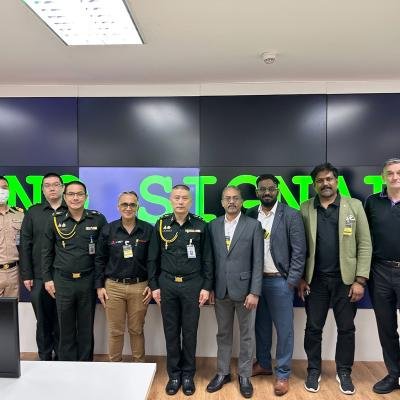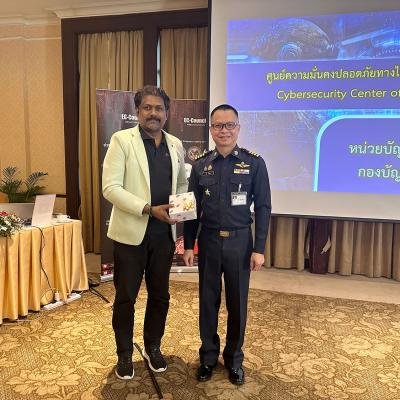In today's digital age, cybersecurity is paramount for businesses of all sizes. Small and medium-sized businesses (SMBs), in particular, have become prime targets for cybercriminals. With limited resources and expertise, they are often ill-prepared to defend against evolving threats. This comprehensive guide delves deeper into the critical topic of cybersecurity compliance for SMBs, offering a thorough exploration of the subject to ensure the protection of your business in the digital era.
Chapter 1: Understanding the Growing Threat Landscape
In our digitally interconnected world, understanding the evolving threat landscape is critical. Cyberattacks continue to surge, and SMBs are increasingly attractive targets. To grasp the significance of cybersecurity compliance, it's crucial to recognize the dynamic nature of cyber threats and the vulnerabilities SMBs encounter.
1.1. Cyber Threat Landscape
The landscape of cyber threats is vast and ever-changing. Cybercriminals employ various tactics, from phishing and malware attacks to ransomware and social engineering. Understanding these threats is fundamental for businesses seeking to safeguard their assets.
- Phishing Attacks: Cybercriminals impersonate trusted entities to trick individuals into revealing sensitive information. This remains one of the most common attack vectors.
- Malware: Malicious software, such as viruses and Trojans, can infect systems and steal data. These programs are continually evolving to bypass security measures.
- Ransomware: Ransomware encrypts files and demands a ransom for decryption. SMBs are often targeted because they are more likely to pay a ransom to regain access to their data.
- Social Engineering: Cybercriminals manipulate individuals into divulging confidential information. This often involves psychological manipulation and impersonation.
- Zero-Day Exploits: Attackers may use unknown vulnerabilities in software or hardware to gain access to systems before they are patched.
1.2. SMB Vulnerabilities
SMBs are often considered low-hanging fruit for cybercriminals due to their limited cybersecurity resources and expertise. Common vulnerabilities include:
- Limited Budget: SMBs often have constrained budgets for cybersecurity, making it challenging to invest in robust security measures.
- Lack of IT Staff: Many SMBs lack dedicated IT personnel with cybersecurity expertise, leaving their systems vulnerable.
- Outdated Software: Failure to update and patch software can leave SMBs exposed to known vulnerabilities.
- Insufficient Employee Training: Without adequate training, employees may unknowingly compromise security through actions like clicking on phishing emails or using weak passwords.
Chapter 2: Navigating the Regulatory Environment
Various regulations and standards have been established to safeguard sensitive data and ensure that companies maintain robust cybersecurity measures. SMBs need to comprehend these regulations and standards to operate in compliance. Failure to do so can result in severe consequences, including fines and legal repercussions.
2.1. General Data Protection Regulation (GDPR)
GDPR is a comprehensive regulation governing data protection and privacy for European citizens. If your business handles the personal data of EU residents, GDPR compliance is not just recommended, it's mandatory. Non-compliance can lead to substantial fines.
Key GDPR Principles:
- Data Minimization: Collect only necessary data.
- Consent: Obtain clear and explicit consent for data processing.
- Data Portability: Allow data subjects to move their data.
- Data Protection Impact Assessment (DPIA): Assess data processing risks.
- Data Breach Reporting: Notify authorities of data breaches within 72 hours.
2.2. Payment Card Industry Data Security Standard (PCI DSS)
PCI DSS compliance is crucial for businesses that process credit card payments. It ensures the secure handling of customer payment data, protecting against data breaches.
Key PCI DSS Requirements:
- Secure Network: Protect cardholder data by maintaining a secure network.
- Vulnerability Management: Regularly update and patch systems.
- Access Control: Restrict access to cardholder data.
- Monitoring and Testing: Implement security monitoring and conduct regular tests.
- Information Security Policy: Develop and maintain a security policy.
2.3. Health Insurance Portability and Accountability Act (HIPAA)
For SMBs operating in the healthcare sector, HIPAA regulations are essential. HIPAA compliance is required to protect patient data, ensuring the privacy and security of health information.
Key HIPAA Rules:
- Privacy Rule: Regulates the use and disclosure of protected health information.
- Security Rule: Sets standards for the protection of electronic protected health information.
- Breach Notification Rule: Requires the reporting of breaches to individuals, HHS, and the media.
- Omnibus Rule: Modifies HIPAA to strengthen privacy and security protections.
2.4. Cybersecurity Maturity Model Certification (CMMC)
For companies working with the U.S. Department of Defense, CMMC compliance is necessary. It ensures the protection of sensitive defense information and classified data.
CMMC Framework Components:
- Domains: The CMMC model consists of 17 domains, each with specific practices.
- Processes: These are the cybersecurity processes that organizations implement.
- Maturity Levels: Organizations are assessed at one of five maturity levels, from "Basic Cybersecurity Hygiene" to "Advanced/Progressive."
Chapter 3: Building a Robust Cybersecurity Framework
Compliance with cybersecurity regulations necessitates the establishment of a robust cybersecurity framework. This framework includes a series of steps and measures designed to enhance security and maintain compliance.
3.1. Risk Assessment
Start with a thorough risk assessment. Identify the unique risks your business faces, taking into account the type of data you collect, store, and transmit. Assess potential vulnerabilities and threats specific to your organization.
- Identify Assets: Determine what data and assets are most critical.
- Threat Assessment: Analyze potential threats that could exploit vulnerabilities.
- Vulnerability Assessment: Assess weaknesses in your systems and processes.
- Risk Calculation: Calculate the likelihood and impact of potential risks.
- Risk Mitigation: Develop strategies to mitigate identified risks.
3.2. Policies and Procedures
Develop clear and comprehensive cybersecurity policies and procedures that align with the relevant regulations. Your employees should be fully aware of these policies, and regular training should be provided to ensure they understand and follow them.
- Policy Development: Create policies that outline acceptable behavior and best practices.
- Employee Training: Train employees on cybersecurity policies and their role in maintaining security.
- Policy Enforcement: Ensure policies are consistently enforced and updated.
3.3. Access Control
Implement strict access control measures. Only authorized personnel should have access to sensitive data, and you should employ strong authentication methods to verify their identities.
- Access Management: Control who has access to sensitive data and systems.
- Authentication Methods: Implement multi-factor authentication to enhance security.
- Access Monitoring: Continuously monitor access to detect unusual or unauthorized activity.
3.4. Data Encryption
Data encryption is a cornerstone of data protection. Encrypt data at rest and in transit to prevent unauthorized access. This adds an extra layer of security to sensitive information.
- Data in Transit: Use encryption protocols (e.g., HTTPS, VPNs) to protect data during transmission.
- Data at Rest: Encrypt data stored on servers and devices to protect against unauthorized access.
3.5. Regular Audits and Testing
Regularly audit your cybersecurity measures and perform penetration testing to identify vulnerabilities. Continuous testing helps you stay ahead of potential threats.
- Security Audits: Conduct regular security audits to ensure compliance and identify weaknesses.
- Penetration Testing: Employ ethical hackers to simulate attacks and uncover vulnerabilities.
- Vulnerability Scanning: Utilize automated tools to scan networks and systems for potential weaknesses.
- Log Monitoring: Continuously monitor logs for suspicious activity and breaches.
3.6. Incident Response Plan
Prepare a comprehensive incident response plan that outlines the steps to take in the event of a cyberattack or data breach. A well-executed response plan can minimize the impact of a security incident.
- Plan Development: Create a detailed incident response plan outlining roles, responsibilities, and procedures.
- Testing and Drills: Regularly test the plan through tabletop exercises and live drills.
- Communication: Establish clear communication channels for reporting incidents.
- Forensic Analysis: Conduct forensic analysis to determine the cause and scope of the incident.
- Containment and Recovery: Take immediate steps to contain the incident and recover affected systems.
- Documentation and Reporting: Document the incident and report it to the relevant authorities when required.
Chapter 4: Essential Cybersecurity Tools and Technologies
Investing in cybersecurity tools and technologies is crucial to bolster your defenses and maintain compliance with cybersecurity regulations. These tools are essential for monitoring, detecting, and mitigating security threats.
4.1. Firewalls and Intrusion Detection Systems (IDS)
Firewalls and IDS are fundamental to network security. They help identify and block malicious activities on your network, preventing unauthorized access and data breaches.
- Firewalls: Filter incoming and outgoing network traffic, allowing or blocking data packets based on security policies.
- Intrusion Detection Systems (IDS): Detect and alert on suspicious or unauthorized activities on the network.
4.2. Antivirus and Anti-Malware Software
Robust antivirus and anti-malware software are necessary to protect your systems from known threats. Regular updates and scans are essential to stay protected.
- Antivirus Software: Scans for and removes known viruses, worms, and Trojans.
- Anti-Malware Software: Detects and removes a wider range of malicious software, including adware, spyware, and rootkits.
4.3. Security Information and Event Management (SIEM) Solutions
SIEM solutions provide real-time monitoring and analysis of security events. They help you detect and respond to potential threats as they happen, enhancing your overall security posture.
- Log Collection: Collect and centralize logs and event data from various systems.
- Event Correlation: Analyze data to identify patterns and potential security incidents.
- Incident Response: Automate responses to security events and alerts.
- Compliance Reporting: Generate reports for compliance purposes.
4.4. Backup and Disaster Recovery Solutions
Regularly back up your data and implement a disaster recovery plan. This ensures that your business can quickly recover from a cyber incident, minimizing downtime and data loss.
- Data Backup: Regularly back up critical data to secure locations.
- Disaster Recovery Plan: Develop a plan for restoring IT systems and data after a disaster.
- Testing and Drills: Periodically test the disaster recovery plan to ensure it works as expected.
- Redundancy: Implement redundant systems and data centers for additional data security.
Chapter 5: Employee Training and Awareness
In the ever-evolving landscape of cybersecurity, employees play a significant role in maintaining security. Even with the most advanced tools, human error can create vulnerabilities. To mitigate this risk, training and awareness are vital.
5.1. Cybersecurity Training
Provide comprehensive cybersecurity training to your employees. Ensure they understand the risks, the importance of compliance, and how to recognize and respond to threats.
- Security Awareness Training: Educate employees about common threats, best practices, and the importance of security.
- Role-Based Training: Tailor training to specific roles and their associated risks.
- Phishing Awareness: Train employees to recognize phishing attempts and report them promptly.
5.2. Phishing Awareness
Phishing attacks are a common vector for cybercriminals. Teach employees how to identify phishing attempts and the steps to take when they encounter suspicious emails or messages.
- Phishing Examples: Show employees real-life examples of phishing emails and websites.
- Reporting Procedures: Establish clear guidelines for reporting suspected phishing attempts.
5.3. Password Hygiene
Password hygiene is critical. Employees should use strong, unique passwords for each account and be trained on password management best practices.
- Password Complexity: Encourage the use of complex, unique passwords.
- Multi-Factor Authentication (MFA): Promote the use of MFA to add an extra layer of security.
- Password Management Tools: Recommend the use of password managers to securely store and generate passwords.
Chapter 6: Continuous Improvement
The cybersecurity landscape is in a constant state of flux. What works today may not be effective tomorrow. To stay ahead of emerging threats, it's crucial to commit to continuous improvement.
6.1. Stay Informed
Keep up to date with the latest cybersecurity threats and trends. Subscribe to cybersecurity news sources, attend relevant webinars, and participate in industry events to stay informed.
- News Sources: Regularly read cybersecurity news from trusted sources.
- Industry Forums: Participate in cybersecurity forums and communities to exchange knowledge.
- Webinars and Seminars: Attend webinars and seminars to learn about emerging threats and best practices.
6.2. Technology Updates
Regularly update your cybersecurity tools and technologies to ensure they can defend against the latest threats.
- Patch Management: Keep all software and hardware systems up to date with the latest patches.
- Product Evaluations: Continuously evaluate your cybersecurity tools to ensure they meet your evolving needs.
6.3. Testing and Evaluation
Continuously test and evaluate your cybersecurity measures. Regular audits, vulnerability assessments, and penetration testing help identify and address weaknesses.
- Security Audits: Schedule regular security audits to assess your organization's compliance and security posture.
- Penetration Testing: Perform regular penetration tests to identify vulnerabilities before attackers do.
- Vulnerability Scanning: Utilize automated tools to scan networks and systems for potential weaknesses.
Conclusion
In today's digitally-driven world, the importance of cybersecurity compliance cannot be overstated, especially for Small and Medium-sized Businesses (SMBs). As the cybersecurity landscape continues to evolve, SMBs find themselves at the forefront of cyber threats, often with limited resources and expertise to protect against them. This comprehensive guide, brought to you by digiALERT, has explored the critical aspects of cybersecurity compliance for SMBs, aiming to empower these businesses to build a robust defense against the ever-expanding threat landscape.
Our journey began by understanding the growing threat landscape. Cyber threats, from phishing and malware attacks to social engineering and zero-day exploits, are diverse and ever-changing. Recognizing these threats and vulnerabilities is the first step in defending your business.
We then navigated through the complex regulatory environment, emphasizing the significance of compliance with standards like GDPR, PCI DSS, HIPAA, and CMMC. Compliance is not just a legal requirement; it is a commitment to safeguarding sensitive data and upholding the trust of your customers.
Building a robust cybersecurity framework is the cornerstone of our guide. A well-designed framework involves risk assessment, comprehensive policies and procedures, stringent access control, data encryption, regular audits and testing, and a well-defined incident response plan. By implementing these elements, SMBs can significantly bolster their cybersecurity defenses.
Essential cybersecurity tools and technologies, such as firewalls, antivirus software, SIEM solutions, and backup and disaster recovery, were highlighted as crucial investments to protect your digital assets. These tools form the front lines in the battle against cyber threats.
The human element in cybersecurity was not overlooked. Employee training and awareness are vital components of a strong cybersecurity posture. By providing education and promoting best practices, SMBs can mitigate the risks of human error and oversight.
Continuous improvement is the ethos that guides every aspect of cybersecurity. The landscape is ever-changing, and SMBs must remain informed, update their technologies, and consistently test and evaluate their security measures to stay ahead of emerging threats.
As we conclude this comprehensive guide on cybersecurity compliance for SMBs, it is essential to remember that cybersecurity is not a one-time task but a continuous commitment. digiALERT is here to support you in this journey, offering a wide range of cybersecurity solutions, training, and expertise to ensure your business remains secure and compliant.
In the digital age, cybersecurity compliance is not just a responsibility but a competitive advantage. By adhering to the principles outlined in this guide and partnering with a trusted cybersecurity provider like digiALERT, your SMB can confidently face the challenges of the ever-evolving digital landscape. Stay vigilant, stay compliant, and stay secure with digiALERT by your side.







